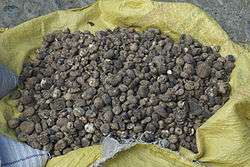Chuño
 | |
| Place of origin | Bolivia and Peru |
|---|---|
| Main ingredients | Potatoes |
|
| |
Chuño (Spanish pronunciation: [ˈtʃuɲo]) is a freeze-dried potato product traditionally made by Quechua and Aymara communities of Bolivia and Peru,[1] and is known in various countries of South America, including Argentina, Bolivia, Chile and Peru. It is a five-day process, obtained by exposing a frost-resistant variety of potatoes to the very low night temperatures of the Andean Altiplano, freezing them, and subsequently exposing them to the intense sunlight of the day (this being the traditional process). The word comes from Quechua ch'uñu, meaning 'frozen potato' ('wrinkled' in the dialects of the Junín Region).
Origins
The existence of chuño dates back to before the time of the Inca Empire in the 13th century, based on findings that have been made of the product at various archeological sites. Specifically, they have been found at Tiwanaku, site of a culture which developed in the Collao Plateau, a geographic zone which includes territories of Bolivia and Peru.
It had been described in 1590 by Spanish chronicler José de Acosta.[2]
Production
After harvest, potatoes are selected for the production of chuño, typically small ones for ease of processing. These small potatoes are spread closely on flat ground, and allowed to freeze with low night temperatures, for about three nights.
Between the freezing nights, they are exposed to the sun, and they are trampled by foot. This eliminates what little water is still retained by the potatoes, and removes the skins, enabling subsequent freezing.
After this, they are exposed to the cold for two additional nights.
Starting from this basic freeze-dry process, two varieties are obtained:
White chuño
White chuño is obtained by "washing" the frozen potatoes. The "washing" may take various forms. In Bolivia , the potatoes are spread on blankets or straw and constantly sprayed with water to moisten. In Peru, the frozen potatoes are transported to a river, and deposited in pools.
The final step is drying in the sun. The result is now called chuño, also known as papas secas. In Bolivia, white chuño is also called tunta.
Black chuño
Black chuño is obtained directly from freezing, trampling, and refreezing. The product is not washed or exposed to water again; after freezing and trampling, it is simply sun-dried.
Preservation and consumption
Once dried, and with minimal care in storage, the product can last for a very long time, sometimes years.[3]
Consumption is varied, from desserts to prepared dishes, as well as chuño flour, which is an essential ingredient in many dishes of Peruvian cuisine. Chairo is one of the most traditional Bolivian soups and it is made with chuño, meat, and vegetables, it is also traditional in southern regions of Peru such as Arequipa and Puno.
See also
References
- ↑ Timothy Johns: With bitter Herbs They Shall Eat it : Chemical ecology and the origins of human diet and medicine, The University of Arizona Press, Tucson 1990, ISBN 0-8165-1023-7, p. 82-84
- ↑ "Potato (white)". The Cambridge World History of Food. Retrieved 22 July 2013.
- ↑ Romero, Simon (August 10, 2016), "A Space-Age Food Product Cultivated by the Incas", The New York Times
| Wikimedia Commons has media related to Chuño. |